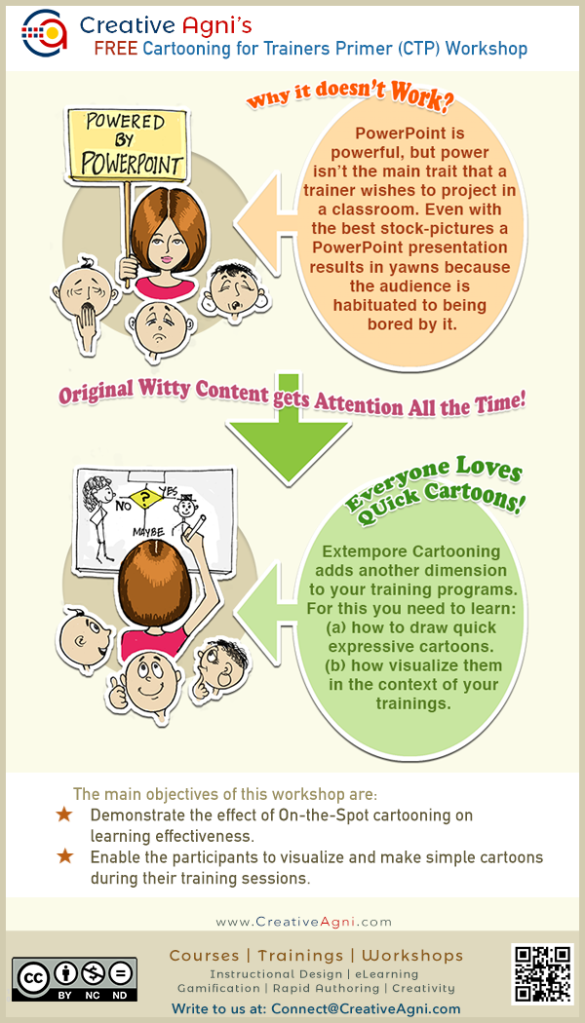A Study that Strayer & Johnson conducted in 2001 confirmed that the probability of missing a red light is about 7% when you are driving while talking on a cell-phone. Replace “missing a red-light” with “meeting an accident” and you know that if you dual task in this specific manner, you are taking a huge risk!
But when your audience dual-tasks in your classroom, it’s an entirely different matter.
To understand the essence of this post, you first need to understand the simple concept called the Attention Hypothesis of Learning, which states that in order to learn the mind needs to “attend” to the learning. When a person does two tasks (dual-tasking) or many tasks (multi-tasking), the mind prioritizes among the tasks. The tasks that don’t require a high degree of cognitive processing are usually done “automatically” and the chances of mistakes are few. On the other hand, tasks that require the active involvement of the brain are “attended” to, consciously.
Five Types of Dual-Tasking Audience
When I look at a non-ideal, completely practical classroom through the lens of the dual-tasking concept, I see five kinds of learners. (Note that the dual-tasking concept lens filters out the single-minded, single-task-oriented, ideal learner.)
- The Doodlers
- The Movers & Shakers
- The Chompers
- The Dreamers
- The Texters
Let us understand each of these magnificent learner types in more depth.
The Doodlers:
Not all doodlers are duds – and I speak from experience, but for the traditional teacher who demands a genuflecting audience, doodlers are the worst in the attention department. Remember, it’s never to late to correct your error. Starting today, realize that these doodlers doodle because of two reasons. 1. They are kinesthetic learners (of course you know – any learning professional worthy or even unworthy of his salt can rattle off the learner types.) 2. They have a deep regard for you and they don’t want to insult you by falling asleep. So, if you find a doodler in your class, get your act together, instead of baring your teeth and growling at the noble doodler.
The icing on the instructional cake is that doodling is a psychomotor skill and it doesn’t tax the learner’s cognitive resources. The learner can still choose to “attend” your lecture and learn from it.
The Movers & Shakers:
Though not very common, this learner-type will shortly invade your classroom. I say so with conviction because I’ve been following each novel idea that’s being implemented in the new education policy. If those ideas could be implemented, sitting in a classroom with headphones on isn’t an unachievable dream and who knows it may become a fundamental right soon! The point that I was trying to make however is, listening to music doesn’t require a lot of cognitive processing. Your auditory audience may still condescend to send some attention your way!
(PS: Remember that you ask them to keep the headphone tacked to one ear only.)
The Chompers:
Chomp, chomp, squeak!
Familiar sounds?
We are speaking of those who dual-task to combine their oral fitness routine with attending your class. Technically speaking, despite their apparently disrespectful attitude, they could be really learning. Chewing is a menial task that the mind has delegated to the front-line executives, the teeth; and they begin their mastication routine without even worrying about what they chew! Obviously then, the chompers are your ideal audience. Their entire cognitive faculty is engaged in but one job, listening to you!
The Dreamers:
Aha! They look smitten by the training, and they readily nod whenever you make that much touted eye contact with them. Don’t assume that they are digesting all that you’ve been telling them. They might be hearing, they might also seem to be listening, but they probably are busy “attending” not to you lecture, but to their dreams. While you give them encouraging smiles and while you strain your vocal cords to explain those arcane concepts; they are busy with their dreams – they are building them, changing them, transforming them – but they aren’t there with you. They are the ones you should be careful about! Daydreams require a lot of cognitive power.
The Texters:
Beware! Those smart texters with that stuck-with-a permanent-glue smile and with busy little fingers; they are the most dangerous audience of all. Texting is a purely cognitive activity, which is done in two complex steps. 1. Thinking up the message. 2. Shortening the message. Typing and sending may have become automated for most of the accomplished texters, but the message has to be thought up and it has to be shortened – tough job, if you ask the practicing content writers.
Thus, texting siphons away the said learner’s attention while you grapple with their weird gestures and funny smiles that make the gentlemen trainers check their fly-zippers and the lady trainers wonder whether they made up only one of their eyes!
Though the dual-tasking audience in your classroom may not kill a pedestrian, but their diverted-attention could be fatal for your lectures. So, starting today – become partial to the Doodlers, the Movers & Shakers, and the Chompers! The Dreamers and the Texters are no friends of yours! Dual task to remember these tips when you deliver your next training program or lecture:-) Do unto them what they do unto you!
You may also be interested in the following link:
Why are cell phones so dangerous for driving?


